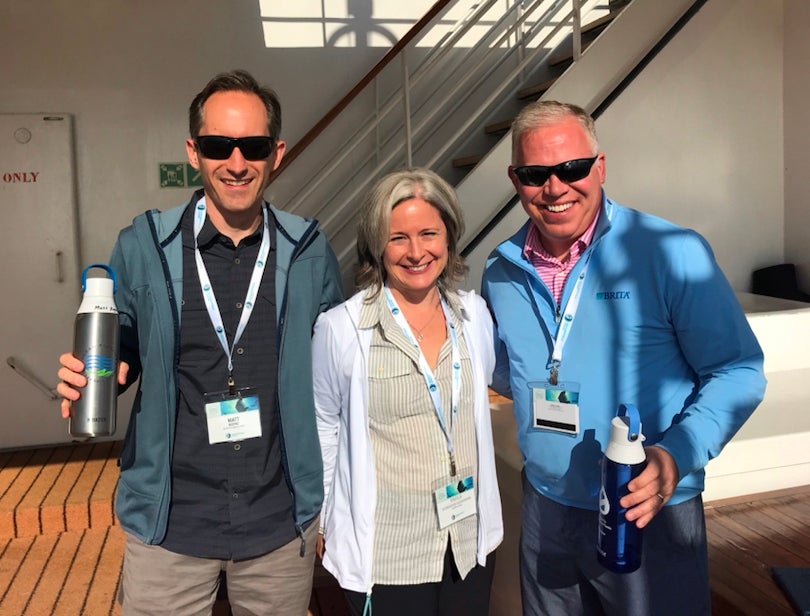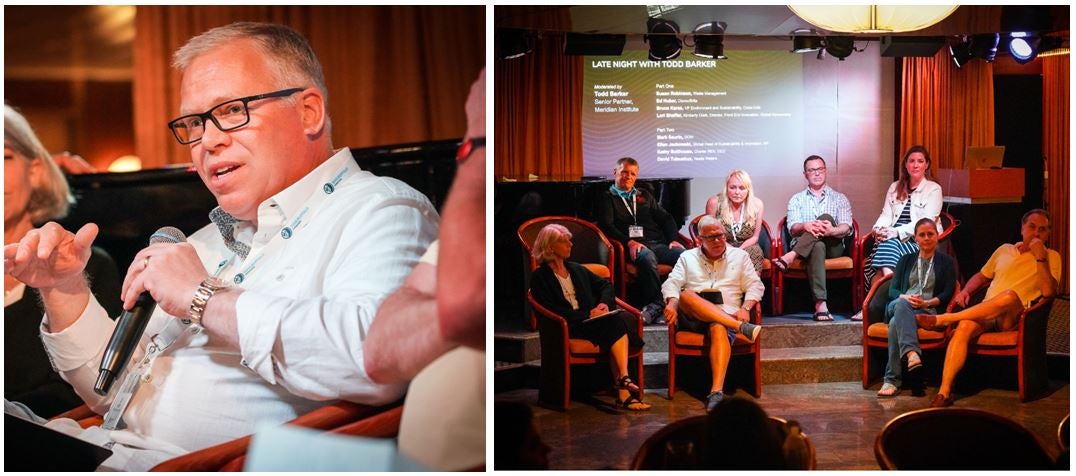Searching for Solutions at the Ocean Plastics Leadership Summit
By Andrea Rudert, associate director – corporate responsibility
Product sustainability has been a focus at Clorox even before we set our first public goal in 2008 to enhance the sustainability of our product portfolio by 50 percent. All progress we’ve made is thanks to the collective efforts of hundreds of individual Clorox people. From supporting Shekinah Eliassen’s actions to join TerraCycle’s Loop program to Shannon Hess’ work to more sustainably source the ingredients that make up Burt’s Bees® products, we continue to empower eco-passionate employees to make a difference.
Inspiration in the Oceanic Gyre
Recently, three of our employees joined the inaugural Ocean Plastics Leadership Summit to inspire solutions to an issue that is threatening our oceanic ecosystems. At the Summit, 150 supply chain leaders, academics, NGOs, scientists and artists gathered on a ship to learn more from various plastics experts. They then left the classroom to experience the situation first-hand as they sailed and snorkeled through one of the world’s five major ocean gyres and collected plastic from local beaches.
Back on board, participants divided into groups for Design Labs, where they collaborated on potential solutions to different aspects of the plastic waste conundrum, from reducing plastic packaging at retail locations to finding ways to recycle small format plastics.
You can read Summit insights and highlights in a report published by the event organizers, Soul Buffalo.
The experience was inspirational and transformative for our attendees. Below are some of their impressions and take-aways:

Clorox’s Matt Kopac, Paula Alexander and Ed Huber
Ed Huber, VP and GM – Brita and Glad
There were two major components to the Summit.
The first was giving dimension to the impact plastics have on our oceans — and our world in general. While many of us have heard the facts — there will be more plastic in the ocean than fish by 2050 and 90% of plastic bottles don’t get recycled — seeing the impact up close while snorkeling in the middle of the Atlantic gyre drives home that this is a problem of incredible magnitude, and we need solutions of both speed and scale.
The second component was the development of actionable solutions. This Summit effectively convened leaders from across the plastics value chain, from plastic suppliers to NGO’s to waste management companies to academics, to share diverse perspectives leading to a broad set of potential solutions. While there is no “silver bullet,” we can make progress on multiple fronts.
I’m proud of the work our brands are already leading in this space and am motivated to do even more. As leaders in our categories, we have expertise and capabilities to deliver impactful and sustainable solutions for our consumers and the planet.

Ed Huber represented Clorox’s Brita and Glad brands at the Ocean Plastics Leadership Summit. Photo credit: Yarrow Kraner
Paula Alexander, Director – Sustainable Business and Innovation for Burt’s Bees
Snorkeling out amongst the sargassum was a defining point in the Summit for me. Sargassum, the seaweed that collects life in this part of the ocean, also collects the waste from some recognizable plastics like lids and even toilet seats. Contrary to my belief, most of the plastic floating around like soup were tiny bits of translucent white. In fact, the 5 Gyre Institute claims that an estimated 5.24 trillion of these little particles weighing 268,940 tons are in our world’s oceans.
With this experience in mind, I worked in a Design Lab group that had an amazing diversity of thinkers and doers. Our focus was on lifecycle design and design for recyclability with representation across the value chain that will help enable systemic solutions to this wicked problem. The team that attended the Summit has already started transferring our experience to others at Clorox and is exploring ways we can implement our learnings.
I left the ship with awe, humility and a sense of urgency. This feeling was reinforced as I spoke to the immigration officer at the Bermuda airport. She was aware of the plastics problem and the Summit, and thanked me while letting me know that the world was counting on us.

Paula Alexander (center)
Photo credits (l-r): Tom Gruber, Bryan Liscinsky, Tom Gruber
Matt Kopac, Manager of Sustainable Business and Innovation – Burt’s Bees
The Summit helped me translate the ocean plastics waste issue from an intellectual understanding to a direct personal experience. By snorkeling in the gyre, scooping up plastics from the ocean and analyzing microplastics in the lab, I left with a more direct connection to the issue and more inspired than ever to take action.
Through the Design Labs and networking, I was also able to forge relationships and identify potential collaborators to help bring tangible solutions back to our business sector. My Design Lab focused on collaboration to promote product, package and business model innovation that can deliver products to people in a way that can support rather than harm nature. We’ve already been in touch post-Summit about taking steps to implement.

Matt Kopac at the Ocean Plastics Leadership Summit. Photo credit: Bryan Liscinsky




